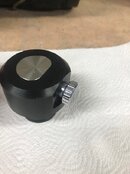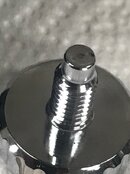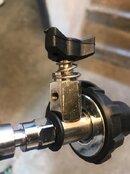Agro
Contributor
CCR Liberty oxygen sensor test kit is designed for automated validation of cells while mounted in the head. This cell tester turns the Libery head into a 3.5 bar pressure chamber. It flushes the head several times with O2, I must manually open the drain valve. Problems:
1) The drain valve is rather poor qualitiy, it looses very small chrome plates, you don't want this in a rebreather.
2) The drain valve is hard to close, it's leaking. I must use a pliers, producing even more chrome plates.
3) The flow is rather small, I have to wait some moments until pressure goes down from 3.5 bar to 1 bar. You have to open the valve several times, that's annoying.
I guess the slow decrease is not necessary for cell test. So I ask myself if I could add another drain valve for ex. the one in the picture (here on a filling hose), it has much more flow and better qualtiy.
What do you thing about this idea?
1) The drain valve is rather poor qualitiy, it looses very small chrome plates, you don't want this in a rebreather.
2) The drain valve is hard to close, it's leaking. I must use a pliers, producing even more chrome plates.
3) The flow is rather small, I have to wait some moments until pressure goes down from 3.5 bar to 1 bar. You have to open the valve several times, that's annoying.
I guess the slow decrease is not necessary for cell test. So I ask myself if I could add another drain valve for ex. the one in the picture (here on a filling hose), it has much more flow and better qualtiy.
What do you thing about this idea?







